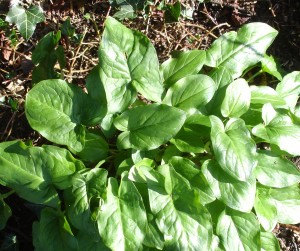Lords and Ladies
Latin: Arum maculatum
Irish: Cluas chaoin
This native species can be seen growing in the boundary hedge beside the 8th tee box. Because of its location these plants sometimes show signs of herbicide damage.
This species comes from a family of perennial herbs (Araceae) that produces numerous small flowers in a compact poker-like structure (the spadix) that is associated with, and often partly enclosed by, a large leafy bract (the spathe) that resembles a monk’s cowl.
The flowers are pollinated by insects attracted to the spadix by its faecal odour and a temperature up to 15oC warmer than the ambient temperature. After the spathe and the other leaves have withered clusters of attractive bright orange-coloured berries are produced.
These berries and other parts are poisonous because of oxalate crystals in them. They can be made safe by boiling or steeping in water and, in the past, the tubers of Arum maculatum were commonly harvested and used for food, but they are very rarely used nowadays.
The ‘Arum’ lily commonly grown in greenhouses is a South African representative of this family.
